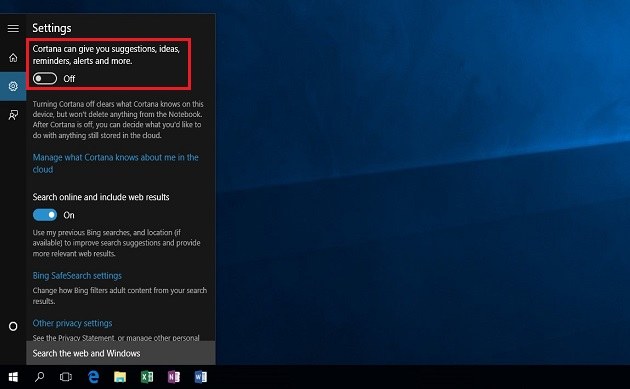
Introduction
Windows 10, Microsoft’s flagship operating system, offers users a versatile and customizable experience. One of the features embedded in the Windows environment is Cortana, the virtual assistant designed to enhance productivity and streamline tasks. However, there are scenarios where users may prefer to turn Cortana off, whether for privacy reasons, personal preference, or to optimize system resources. In this extensive guide, we will explore the significance of turning Cortana off in Windows 10, the steps involved in disabling this feature, and considerations to keep in mind when making this decision.
Understanding the Importance of Turning Cortana Off
While Cortana is a powerful tool for voice-activated assistance and personalized recommendations, there are various reasons why users might opt to turn it off. Privacy concerns, the desire for a streamlined desktop experience, or the preference for alternative productivity tools are among the motivations behind disabling Cortana. Turning off Cortana provides users with greater control over their system’s behavior and privacy settings, allowing for a more customized and tailored Windows 10 experience.
The Advantages of Turning Cortana Off
- Privacy Control: Disabling Cortana allows users to have more control over the information shared with the virtual assistant. This can be particularly important for individuals who prioritize privacy and wish to limit the data collected by Microsoft.
- System Resource Optimization: Cortana, being an active voice-activated assistant, utilizes system resources. Turning it off can contribute to optimizing system performance, especially on devices with limited resources.
- Simplified User Interface: Some users prefer a simplified desktop experience without the presence of a virtual assistant. Disabling Cortana removes its interface and interactions, resulting in a cleaner and less cluttered user interface.
- Reduced Distractions: For users who find Cortana’s prompts and suggestions distracting, turning it off minimizes interruptions and allows for a more focused work environment.
Step-by-Step Guide: Turning Cortana Off in Windows 10
Now, let’s delve into the detailed process of turning Cortana off in Windows 10:
Step 1: Open Cortana Settings
Click on the Cortana icon on your taskbar or press the Windows key and type “Cortana” to open the settings menu. Select “Settings” from the available options.
Step 2: Navigate to “Talk to Cortana” Settings
Within the Cortana settings, navigate to the “Talk to Cortana” section. Here, you will find options related to how Cortana responds to your voice commands and interactions.
Step 3: Disable “Hey Cortana” and Other Options
Toggle off the “Hey Cortana” option to disable the voice activation feature. Additionally, you can disable other options such as keyboard shortcuts and lock screen access if you wish to further restrict Cortana’s presence.
Step 4: Adjust Permissions in “Permissions & History”
Navigate to the “Permissions & History” section within Cortana settings. Review and adjust permissions related to accessing your location, contacts, browsing history, and other data. Toggle off permissions that you want to restrict.
Step 5: Clear Personal Data (Optional)
If you want to clear personal data that Cortana has collected, you can click on “Clear” under the “Clear your device data” section. This step is optional but can be relevant for users who want to erase any stored information.
Step 6: Unpin Cortana from Taskbar (Optional)
If you want to remove Cortana from the taskbar, right-click on the Cortana icon, hover over “More,” and select “Unpin from taskbar.” This step is optional but contributes to a cleaner desktop interface.
Step 7: Disable Cortana in Group Policy (Optional)
For users with Windows 10 Pro, Enterprise, or Education editions, there is an option to disable Cortana through the Group Policy Editor. Type “gpedit.msc” in the Run dialog (Windows key + R), navigate to “Computer Configuration -> Administrative Templates -> Windows Components -> Search,” and double-click on “Allow Cortana.” Set it to “Disabled” and click “Apply.”
Step 8: Disable Cortana in Registry Editor (Optional)
For advanced users, Cortana can be disabled through the Registry Editor. Type “regedit” in the Run dialog, navigate to “HKEY_LOCAL_MACHINE\SOFTWARE\Policies\Microsoft\Windows,” and create a new key called “Windows Search” if it doesn’t exist. Inside this key, create a new DWORD (32-bit) Value named “AllowCortana” and set its value to “0.”
Step 9: Restart Your Computer
After making changes to Cortana settings, permissions, or system configurations, it is recommended to restart your computer to ensure that the changes take effect.
Considerations and Caveats
- Windows Edition: Some features, such as using the Group Policy Editor or Registry Editor to disable Cortana, may require specific editions of Windows 10, such as Pro, Enterprise, or Education.
- Updates and Changes: Microsoft occasionally updates Windows 10, and the availability of certain options or the location of settings may change. Stay informed about updates and changes to ensure accurate information.
- Functionality Impact: Disabling Cortana may impact certain functionality, such as voice-activated search and personalized recommendations. Consider the potential impact on your workflow before deciding to turn Cortana off.
- Personal Preferences: The decision to turn off Cortana is subjective and depends on personal preferences. Evaluate your own preferences, privacy concerns, and workflow requirements when making this decision.
Conclusion
Turning Cortana off in Windows 10 is a customizable option that empowers users to tailor their desktop experience to their preferences and privacy considerations. By following the comprehensive step-by-step guide provided in this overview, users can navigate the process of disabling Cortana with confidence, ensuring a more streamlined and personalized interaction with their Windows 10 environment. As technology continues to advance, the flexibility to customize features like Cortana exemplifies Microsoft’s commitment to providing users with a versatile and user-centric operating system. Whether motivated by privacy concerns, system resource optimization, or personal preferences, the ability to turn Cortana off grants users greater control over their Windows 10 experience.